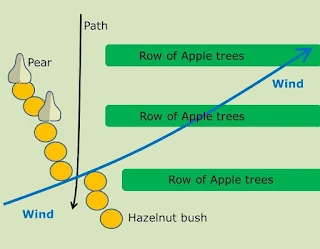 |
| Orange circles are approximate locations of hazelnut bushes. |
One of the advantages of getting a little bit older is that I rarely jump when an idea first pops into my head.
That worked to my advantage in the concept of how I laid out the windbreak for my orchard.
I was originally trapped into the thinking East-West-North-South. The problem with that thinking was the slope of the land. The southwest corner of the property is about 15 feet below the rest of the orchard area. I was concerned that the wind would blow right over the tops of my windbreak and whip the apple trees.
The other issue is that the prevailing winds are from the west-southwest. Planting square-to-grid was not the best way to shield my trees.
I may be a slow thinker but in this case I gave myself enough time to recognize the obvious. The windbreak "wanted" to be planted with the contour of the land.
That allowed me to stitch in a couple of existing pear trees. I also had to put a gap in the windbreak for a path but that presented little difficulty.
Once I divorced myself from square-to-grid thinking, I had the presence of mind to extend the windbreak south of the orchard to more fully shield it from the wind's preferred quadrant.
Some pictures
 |
| Looking west from the apple orchard. You get a feeling for how this plateau is significantly higher than the flats where the wind picks up speed. Stakes are about 7' apart. |
 |
| It took about an hour to move the eight hazelnut bushes. If I get ambitious I may plant more bushes between the ones I planted today. The top of the stake is belt high. |
 |
| This is a typical shape for a hybrid hazelnut bush but I expect mine to only reach 12' to 15'. |




Would a second row that is offset to the current one be something to consider for preserving the windbreak if one or more in the line were to die?
ReplyDeleteI went through today and planted bushes in between the ones I planted yesterday.
DeleteBushes will die. Not all of them will be immune to the Eastern Filbert Blight. I also like to plant them close together so I can cull the inferior specimens.
Another strategy is to plant a second, shorter species to fill the gaps at the bottom. Examples would be blackberries, currants, dogwood, spicebush...
Wind breaks seem to work best with 50% solid and will block wind for 7x the height.
ReplyDeleteLooks like the 'delay' gave you time to fix the idea more firmly, and plan it better!
ReplyDeletepreserving the windbreak if one or more in the line were to die?
ReplyDeleteทางบ้าน